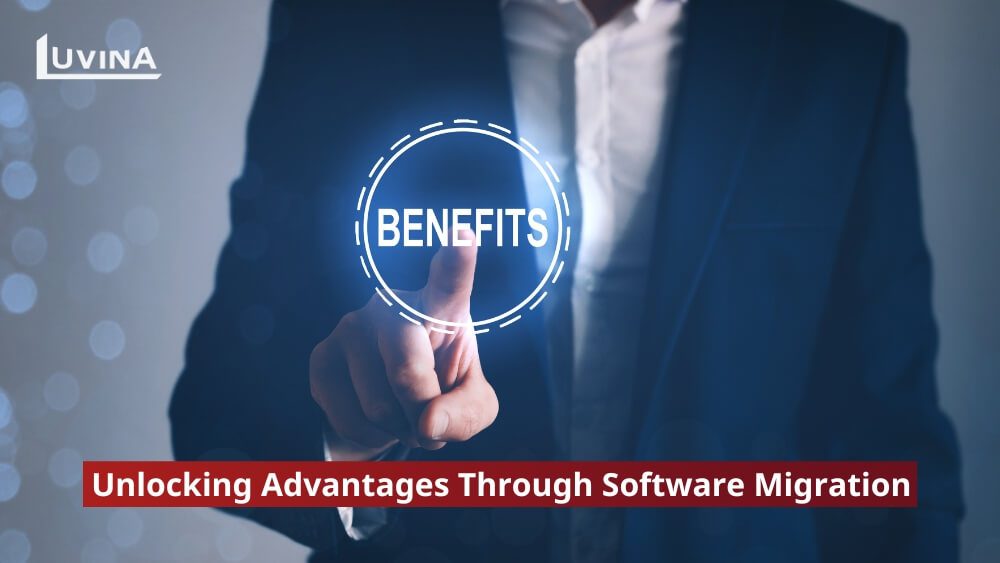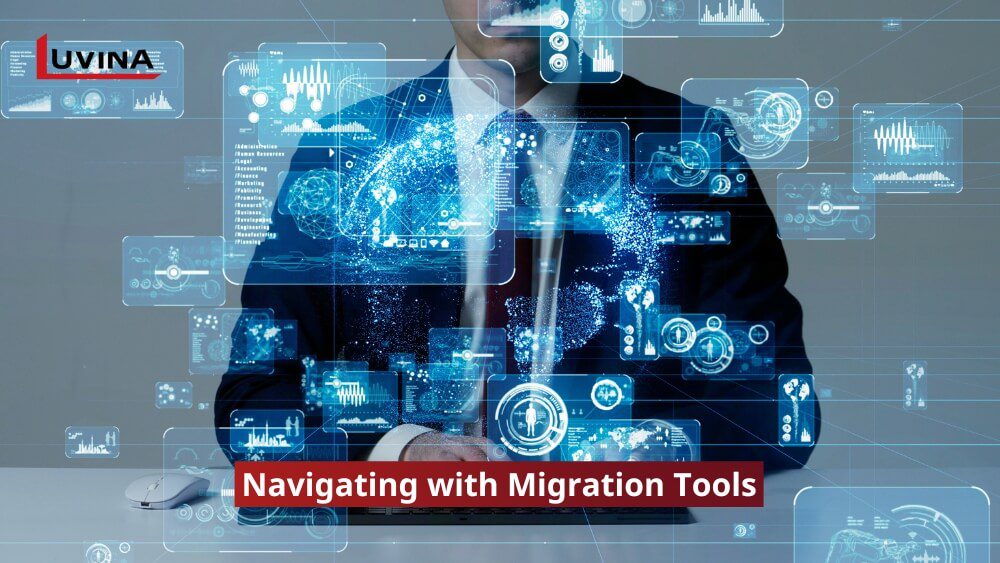The necessity for software migration has become a key element in the growth of organizations. This complicated process involves the transfer of data, applications, or entire systems from one environment to another. But what makes software migration so important?
This blog will provide you with an insightful introduction to software migration, discovering its importance and listing common conditions that spark these transformative efforts. Join us on this journey as we explore the strategic significance of software migration and its potential to drive businesses into a future of innovation and adaptability.
Advantages of Software Migration
Embracing software migration emerges as a strategic move laden with benefits. Let’s delve into two key aspects that underscore the transformative advantages of this process.

1. Enhanced System Performance
Software migration acts as a trigger for optimizing system performance. It ensures the system operates smoothly in the new environment by fine-tuning the application and infrastructure.
Businesses experience improved speed, efficiency, and overall responsiveness of their systems through performance enhancements. This not only elevates user experience but also lays the foundation for increased productivity across various operational facets.
2. Improvements in Security and Compliance
Security considerations often drive the decision to migrate software. Legacy systems may be incapable of providing effective protection in an ever-changing threat scenario. Organizations can enhance their defenses by switching to contemporary, secure platforms, which protect sensitive data and ensure compliance.
In essence, software migration goes beyond mere technological adaptation; it paves the way for heightened performance, fortified security, and alignment with regulatory standards. Join us as we navigate through the spectrum of advantages that await organizations on their software migration journey.
Challenges of Software Migration
While the prospect of software migration promises a pantheon of benefits, it is not devoid of challenges that demand sagacious navigation. Let’s embark on a discerning exploration of the common tribulations encountered during the migration odyssey, coupled with astute insights on mitigating these challenges.

1. Identifying Common Issues During the Migration Process
In the tapestry of software migration, intricacies often manifest as challenges that warrant careful consideration. The upheaval of data, potential downtime, and the intricate task of maintaining business continuity stand out as perennial challenges.
The intricacies extend to compatibility issues, wherein legacy systems grapple with the seamless integration of contemporary platforms. Data integrity and security concerns also loom, necessitating a meticulous approach to ensure a coherent and secure transition.
2. Insights on Mitigating Challenges
The method of performing a software migration includes analyzing the current system in detail, evaluating and predicting possible errors, and finally creating a migration strategy.
A robust migration plan is built upon rigorous testing, successful phase implementation, and a proper recovery plan. To do that, your organization needs to conduct foundational knowledge training for employees from today or leverage a team of experienced outsourcing experts.
In this nuanced exploration, we decipher the challenges inherent in the software migration terrain, framing them not as insurmountable barriers but as catalysts for strategic transformation. By understanding, anticipating, and adeptly mitigating these challenges, organizations pave the way for a seamless migration journey, ensuring the realization of the transformative potential encapsulated in the migration narrative. Join us as we unravel further layers of insight, demystifying the art and science of software migration.
Choosing the Right Migration Strategy
Embarking on a software migration journey necessitates a thoughtful selection of the migration strategy, a decision pivotal to the project’s success. In this segment, we delve into the diverse array of migration approaches, facilitating an informed comparison to guide organizations in pinpointing the strategy that aligns seamlessly with their unique needs.

1. Comparing Various Migration Approaches
The migration landscape unfolds with an array of strategies, each tailored to address specific scenarios. Lift and shift, re-platforming, re-architecting, and complete application re-engineering constitute the spectrum of choices.
The “lift and shift” approach involves a straightforward migration of applications without significant modification. Re-platforming entails a change in the underlying infrastructure, optimizing for the target environment. Re-architecting involves restructuring the application, and complete re-engineering is a ground-up reconstruction.
2. How to Select the Most Suitable Strategy
The most effective migration plan is based on a thorough understanding of current systems, organizational goals, and desired migration outcomes. Organizations must consider factors such as time constraints, budget considerations, and the desired level of transformation.
For legacy systems seeking a swift transition, “lift and shift” may offer expediency. In contrast, projects aspiring for innovation and scalability may find re-architecting or re-engineering more aligned with their objectives. A comprehensive review of these factors ensures a balanced alignment between the chosen strategy and the vision of the organization.
As we build a software migration strategy for your business, we try to provide your organization with the knowledge you need to make informed decisions. Join us on this insightful exploration, where the right migration strategy turns challenges into opportunities for growth.
Tools and Technologies for Seamless Software Migration
In the realm of software migration, the choice of tools and technologies serves as the compass guiding organizations through the intricate process. This section illuminates the landscape by introducing prominent tools designed to facilitate a smooth migration journey and emphasizes the critical role of technology choices.

1. Introducing Popular Migration Tools
Countless tools have emerged to streamline the migration process. Notable mentions include AWS Server Migration Services, Azure Migration, and Google Cloud Migration Center. These tools cater to different cloud ecosystems, providing functions such as server discovery, assessment, and streamlined migration processes.
Each tool possesses unique features, addressing specific aspects of the migration process. While some excel in automated server transfers, others focus on meticulous assessments, ensuring a tailored approach to diverse migration needs.
2. The Importance of Technology Choices
The significance of technology choices reverberates throughout the migration lifecycle. Optimal tools seamlessly integrate with the existing tech stack, minimizing disruptions and optimizing performance.
Technological decisions extend beyond migration tools, encompassing considerations like programming languages, frameworks, and database solutions. A detailed evaluation of technology choices ensures compatibility, scalability, and resilience in the post-migration landscape.
Best Practices for Software Migration
Embarking on a software migration journey requires a strategic approach and adherence to best practices to overcome potential challenges. This section provides you with specific methods to implement each phase simply and effectively.
1. Thorough Planning
Meticulous planning is the cornerstone of a successful migration. Before implementation, organizations must conduct a comprehensive assessment of their current software environment, identifying dependencies, potential bottlenecks, and benchmarking performance.
Develop a detailed migration plan that clearly outlines specific goals, timelines, and contingency measures. Consider engaging key stakeholders to establish alignment with company goals.
2. Risk Assessment and Mitigation
You should do a thorough risk assessment to identify potential issues and implement mitigation solutions. Create a prioritized list of risks based on their potential influence on business operations, and then plan your treatment accordingly. Additionally, regularly reassess risks throughout the migration process to adjust your strategy accordingly.
3. Clear Communication and Training
Transparent communication is vital for a successful migration. Keep all stakeholders informed about the migration plan, potential disruptions, and expected outcomes. Establish communication channels for feedback and updates.
Your enterprises need to provide comprehensive training for personnel involved in the migration process. Ensure that employees are familiar with the new system to ensure optimal productivity during the transition.
4. Testing and Validation
Rigorous testing is key to a successful migration. Conduct extensive testing of new systems in a controlled environment to identify and fix potential issues before full implementation.
You should establish authentication processes to verify data integrity, system functionality, and performance. Repeated application testing for refinement, ensuring a seamless user experience after migration.
>> Also read: The Importance of Migration Testing in Software Testing
5. Post-Migration Monitoring and Optimization
The migration journey doesn’t end with deployment; attentive post-migration monitoring is essential. You definitely need to deploy monitoring tools to monitor system performance, identify anomalies, and resolve issues promptly.
Continuously optimize migrated systems based on performance insights and user feedback. This iterative approach enhances long-term system efficiency and user satisfaction.
By adhering to these best practices, organizations can steer their software migration ship with confidence, minimizing disruptions, and ensuring a successful transition to new horizons.

Emerging Trends in Software Migration
Software migration changes in response to new technological obstacles and opportunities. This section examines the prospective trends and technologies that are influencing the future of software migration services.
1. Containerization and Microservices
Containerization technology, such as Docker and Kubernetes, is becoming necessary in software migration plans. Containers provide a lightweight, scalable, and consistent environment, simplifying migration and deployment.
Another approach that can be mentioned is microservice architecture with increasingly prominent modular and independent components. This approach increases flexibility, making it easier to move, update, and scale individual services.
2. AI and Automation
Artificial intelligence (AI) and automation are revolutionizing software migration. AI-powered tools analyze the codebase, identify dependencies, and recommend optimal migration paths. Automation streamlines repetitive tasks, reducing manual effort and potential errors.
Machine learning algorithms are increasingly employed to predict potential issues during the migration, allowing proactive mitigation before deployment.
3. Edge Computing Integration
Migration strategies are evolving to adapt decentralized architectures due to the rise of edge computing. Edge computing links compute resources closer to data, reducing latency and increasing performance. The software migration plan is currently considering the implications of integrating applications with edge computing environments, ensuring optimal performance in distributed ecosystems.
4. Serverless Computing
– Serverless computing, where cloud providers manage infrastructure dynamically, is influencing migration paradigms. Organizations are exploring serverless architectures for certain workloads, reducing operational overhead and costs.
– Serverless computing aligns with the pay-as-you-go model, providing cost-effective solutions for specific use cases within the migration journey.
As organizations begin to look toward the future of software migration, these emerging trends promise to shape a more efficient, secure, and adaptive landscape. Tracking these developments ensures that migration strategies remain resilient to evolving technological flows.
Related Posts:









Read More From Us?
Sign up for our newsletter
Read More From Us?
Sign up for our newsletter